One of the most important lessons I have learned is never, ever to presume. However, I was to fall foul of these wise words.
My tale unfolds from around 1998 when I became the owner of my much-loved XJ6 Series 1. The car had sat in a garage for several years and, although drivable, revealed a number of “lack of use” niggles, one of which was the fuel gauge not working for either tank. You can understand how annoying this can be, so my first tack was to try a new fuel gauge.
I purchased another bank of gauges at Battlesbridge, being assured by the seller that the unit was a “good un”. Following installation, however, the gauge did not move so I bit the bullet, drained the fuel tanks and removed the fuel senders.
This proved to be a good move as both senders had rusted away and required replacement. The XJ has the senders fitted within the front inside area of the rear wheel arch. This position allows good access to the tanks and I could push a cloth into the tanks and have a good clean around, removing any old debris inside.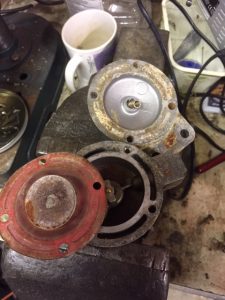
Whilst working on the fuel tanks, I checked the water trap that is contained in the boot’s spare wheel compartment. The fuel inside looked completely clear but I still removed the bowl cleaned and replenished it. A quick look in the engine bay revealed an inline aluminium casting with a bowl filter which appeared to have some form of adjustment screw fitted in line just behind the carbs. I now know this to be a Malpassi Regulator.
I considered pulling this unit apart, presuming that it may have a filter of sorts inside. But, knowing the fuel filter in the boot was clear, while the tanks were clean and filled with fresh fuel, I presumed that everything else was in good order. I decided to leave well alone and have a fire up. All went well; the fuel gauge worked on both tanks and the car was up and running.
I spent the following years traveling around the UK and Europe including trips to Le Mans, Laon, Caen and Honfleur. In April 2019 we had a great week driving around Holland with other club members, posing for photos at Arnhem Bridge. Over the years I’ve had great delight in telling everyone how reliable the XJ6 has been. I’ve never missed an opportunity to rub salt into the wounds of those with newer cars that fell by the wayside. I had, by the way, failed to mention the time that my rear brake callipers gave up and I left a ton of brake fluid on the stately driveway at Helmingham Hall (yet another tale…).
However, my luck ran out in June 2019 on the drive back from the Stanford-le-Hope / Corringham car show. Returning home along the A130, Julie and I both felt the holdback or miss in the engine running. I looked at Julie and asked “Did you feel that?”
Then, a complete loss of power as we rolled along the A130, only for the engine to recover and then falter yet again. I was asking myself: fuel? electrics?
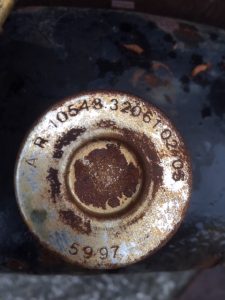 With a dozen options flying around in my head I managed to pull over, half on and half off the main carriageway. I waited, said a prayer and turned the key. The engine ran again for another 100 yards or so, but the same problem returned, leaving us rolling to a standstill just before the brow of the hill which leads down towards the Army and Navy roundabout.
Could it be fuel starvation? Perhaps the float chamber needles were sticking? (The ones that are shaped like the Lucas fuses ) Or has the coil or points let me down? Armed with all the tools I had on board (a plug removing socket bar), I set about said floats and anything else which might help, including the aluminium fuel unit fitted just before the carbs.
With a dozen options flying around in my head I managed to pull over, half on and half off the main carriageway. I waited, said a prayer and turned the key. The engine ran again for another 100 yards or so, but the same problem returned, leaving us rolling to a standstill just before the brow of the hill which leads down towards the Army and Navy roundabout.
Could it be fuel starvation? Perhaps the float chamber needles were sticking? (The ones that are shaped like the Lucas fuses ) Or has the coil or points let me down? Armed with all the tools I had on board (a plug removing socket bar), I set about said floats and anything else which might help, including the aluminium fuel unit fitted just before the carbs.
It was at this point that my navigator and helpful assistant suggested we call the RAC and get it lifted home. If I’m really honest, this was a dent to my pride and caused my mind to race; what if club member were to see me?
Back in the car and a turn of the key found the engine running again and sounding good. I drove somewhat cautiously down to the Army and Navy roundabout. All seemed back to normal arriving back on my driveway and, wondering if a tap on the fuel bowl had actually cured the problem, I put the Jag away promising myself I would take a further look the following day.
Monday morning, the car fired up and seemed OK. I could have left things as they were, but I was thinking about a full carburettor service so I removed the float chambers. All looked clean and in order as did the fuel water trap in the boot therefore, venturing into the unknown, I decided to strip the unknown fuel unit fitted in the engine bay. Disassembly was quite straightforward.
I suppose I knew that there would be some form of filter inside, but I was amazed at what I found inside the regulator. It was unbelievable and a credit to the Malpassi unit that the car had managed to run for this long in that condition. I took a number of pictures, from which I hope you can see the amount of crud, rust, paper filter and mass of hard brown stale fuel gunk that had filled the unit.

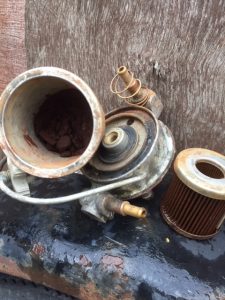 Any normal classic car owner would have just purchased a new unit outright but, saving a pound I managed to source new parts for the original unit. When fitted, it ran OK but I still felt a slight hesitance, so back onto eBay and I purchased and fitted a new one. I could now feel a vast improvement; the car felt alive again and of course delivers fuel at a set pressure to the carbs.
Any normal classic car owner would have just purchased a new unit outright but, saving a pound I managed to source new parts for the original unit. When fitted, it ran OK but I still felt a slight hesitance, so back onto eBay and I purchased and fitted a new one. I could now feel a vast improvement; the car felt alive again and of course delivers fuel at a set pressure to the carbs.
The Malpassi regulator is advertised as a very popular unit for carburettor-equipped cars, as it both regulates fuel pressure and filters fuel without restriction. Pressure is adjusted via a screw on the top of the unit and the range is 1½ to 5psi. The filter bowl is easily removed to enable the filter element to be replaced. The larger model units are fitted to performance cars and have a pressure gauge attached.
It is my understanding that electronic pumps can deliver fuel to the chambers at a rate of 5 psi which can cause flooding or possibly vaporisation issues (not sure about the latter). With the Malpassi installed you can reduce this pressure to an even delivery of 1½ to 3 psi.
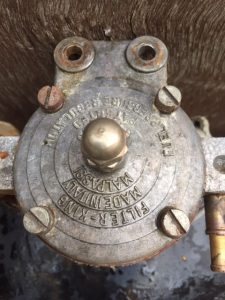
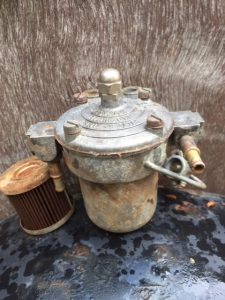 The stated purpose of the pressure filter is to save fuel by improving fuel economy of carburettor-equipped engines. The theory of operation states it reduces and regulates fuel pressure to the float chambers in such a way as to eliminate the detrimental effects of fuel sloshing and pressure pulsations which occur during conventional vehicle operation.
The stated purpose of the pressure filter is to save fuel by improving fuel economy of carburettor-equipped engines. The theory of operation states it reduces and regulates fuel pressure to the float chambers in such a way as to eliminate the detrimental effects of fuel sloshing and pressure pulsations which occur during conventional vehicle operation.
Further reading revealed an early American evaluation of the unit; it concluded that, whilst it is probably true that some fuel can be wasted as a result of over-enrichment due to sloshing and late closing of the float valve, there is no evidence that such losses are significant or that the device can minimise them. Looking on numerous car forums, many of our sports cars are fitted with the pressure filters. SU carbs require 1½ to 3psi and if you run Dells or Webers you need to limit fuel pressure to 3 to 3½ psi, so it would make sense to fit a regulator.
From a personal view, it seemed to smooth the running of the XJ6 and save my carbs from dirt in the fuel. Also, I have to say my 4.2 litre is not an excessive fuel guzzler. Recently on trips to our Maldon professional car restorers I saw the very same unit fitted to other Jags and classic Ferraris, which I thought was a good recommendation.
So to conclude my tale; just because my fuel tanks looked clean and the water trap was clear I had presumed the unit which I did not recognise attached to the fuel line near the carbs couldn’t possibly be full of dirt and rubbish; why would it be? Again, never presume!
Vaughn High

